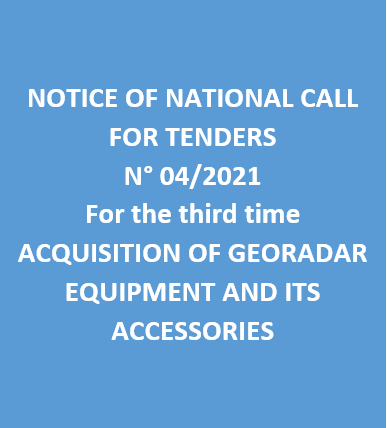| Annual program and technical progress report |
-

Activity Report 2023
-

Technical Program 2024
|
| Geocatalogue |

|
| Invitation to
tender |
-

REALIZATION OF THE TRAINING PLAN FOR THE YEAR 2022
-

ACQUISITION OF TWO SERVICE CARS
-

ACQUISITION OF GEORADAR EQUIPMENT AND ITS ACCESSORIES
|
|
Invest in Tunisia |

|
|
|
|
|
::
Documentation and Editions
>>
Research library
|
| |
|
[
Search by author
]
[
Search keyword
]
[
Search by index
]
[
Search by category
]
|
title of the reference :
|
Biostratigraphy and isotope stratigraphy and the catastrophic extinction of calcareous nannoplankton at the Cretaceous/Tertiary boundary
|
|
Publication Date:
|
1982
|
|
Author :
|
Perch Nielsen Katharina, Mckenzie Judith, Quziang He, Silver L.T.
|
|
Catalogue type :
|
Livre
|
|
Catalogue reference :
|
(USA) Geol. Soc. Am. : Sp. Pap. Biostratigraphy and isotope stratigraphy and the catastrophic extinction of calcareous nannoplankton at the Cretaceous/Tertiary boundary Biostratigraphie, stratigraphie isotopique et extinction catastrophique des nanoplanktons calcaires lors du passge crétacé/Tertiaire " The biostratigraphy of Cretaceous/Tertiary boundary sections from eight localities is summarized and compared in order to define a continuous or complete section. The El Kef, Tunisia, section is apparently the thickest C/T boundary section as yet described and contains all the biostratigraphical criteria required to define a complete section: that is, the uppermost Cretaceous Micula prinsii Zone, the""boundary clay"" within the lowermost Tertiary Globigerina fringa Zine, followed by the Globigerina eugubina and pseudobulloides Zones. Using these Zonations, a correlation of the stable-isotope stratigraphy from the sections was made. The latest Cretaceous oceans and the earliest Tertiary oceans contained significantly different isotopic signals, which were incorporated into the tests of the calcareous nannofossils. The carbon-isotope signals are apparently global, synchronous, and primarily determined by changes in oceanic fertility, whereas the oxygen-isotope signals are globally induced but modified regionally according to paleogeographic position and paleocirculation patterns. Further, this combination of biostratigraphy and isotope stratigraphy indicates that Cretaceous nannofossils in the lowest Tertiary sediments, previously thought to be reworked, actually survived the C/T boundary, events and continued to reproduce in the earliest Tertiary oceans. These relic species became extinct some tens of thousands of years after the actual C/T boundry, probably as a consequence of the environmental stress following the C/T boundary events rather than as a result of a ""catastrophic"" extinction coinciding with the C/T boundary." bibliogr. Maestrichtien ; Danien ; limite stratigraphique ; Algae ; nanofossile ; biostratigraphie ; taxinomie ; extinction ; isotope ; zonalité ; rapport chimique ; C13 C12 ; O18 O16 ; sédiment ; iridium ; circulation océanique ; donnée MEB ; Tunisie ; RFA ; France ; Espagne ; Italie ; océan Atlantique Sud ; océan Pacifique Mckenzie Judith Quziang He Silver L.T. Perch Nielsen Katharina Stratigraphie
|
|
Indexation decimale :
|
Stratigraphie
|
|
Keywords :
|
Maestrichtien ; Danien ; limite stratigraphique ; Algae ; nanofossile ; biostratigraphie ; taxinomie ; extinction ; isotope ; zonalité ; rapport chimique ; C13 C12 ; O18 O16 ; sédiment ; iridium ; circulation océanique ; donnée MEB ; Tunisie ; RFA ; France ; Espagne ; Italie ; océan Atlantique Sud ; océan Pacifique
|
|
Summary :
|
" The biostratigraphy of Cretaceous/Tertiary boundary sections from eight localities is summarized and compared in order to define a continuous or complete section. The El Kef, Tunisia, section is apparently the thickest C/T boundary section as yet described and contains all the biostratigraphical criteria required to define a complete section: that is, the uppermost Cretaceous Micula prinsii Zone, the""boundary clay"" within the lowermost Tertiary Globigerina fringa Zine, followed by the Globigerina eugubina and pseudobulloides Zones. Using these Zonations, a correlation of the stable-isotope stratigraphy from the sections was made. The latest Cretaceous oceans and the earliest Tertiary oceans contained significantly different isotopic signals, which were incorporated into the tests of the calcareous nannofossils. The carbon-isotope signals are apparently global, synchronous, and primarily determined by changes in oceanic fertility, whereas the oxygen-isotope signals are globally induced but modified regionally according to paleogeographic position and paleocirculation patterns. Further, this combination of biostratigraphy and isotope stratigraphy indicates that Cretaceous nannofossils in the lowest Tertiary sediments, previously thought to be reworked, actually survived the C/T boundary, events and continued to reproduce in the earliest Tertiary oceans. These relic species became extinct some tens of thousands of years after the actual C/T boundry, probably as a consequence of the environmental stress following the C/T boundary events rather than as a result of a ""catastrophic"" extinction coinciding with the C/T boundary."
|
|
Exemplaries :
|
TU1228
|
|
|
|
|
|
|
|



